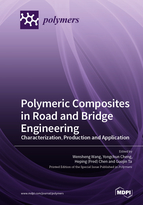Polymeric Composites in Road and Bridge Engineering: Characterization, Production and Application
A special issue of Polymers (ISSN 2073-4360). This special issue belongs to the section "Polymer Applications".
Deadline for manuscript submissions: closed (25 December 2022) | Viewed by 30736
Special Issue Editors
Interests: nondestructive testing technology; structural health monitoring; bridge and infrastructure engineering; road materials and pavement design
Special Issues, Collections and Topics in MDPI journals
Interests: pavement engineering; construction materials; polymers; viscoelastic properties; asphalt & cement-based materials; advanced pavement material design
Interests: digital image processing; numerical simulation; cloud manufacturing; advanced materials; human-robot interaction/cooperation; design optimization
Interests: small and medium span bridge detection; bridge reliability assessment and reinforcement; bridge structural dynamics; performance evaluation of existing bridge structure
Special Issues, Collections and Topics in MDPI journals
Special Issue Information
Dear Colleagues,
Roads, bridges, airports, and ports are multirole transportation infrastructure assets, which rely heavily on asphalt, cement, and aggregates in traditional civil engineering. Multirole transportation infrastructures should be resistant enough against structural loads and vehicle loads. Further, multirole transportation infrastructures are greatly affected by climate change, which has the potential to impact both long- and short-term infrastructure performance. Recent developments in materials science, especially polymers, have brought new perspectives in the modification of civil engineering materials and consequent improvements. Being both strong and lightweight, polymer composites have already found wide-ranging uses in civil engineering. The application of various types of polymers includes admixtures and additives (e.g., alternative binders, polymer fibers) for enhanced mechanical performances and enhanced functional properties such as self-healing and self-cleaning. Therefore, it is necessary to analyze advanced functional polymer composites sitting at the intersection of physics, chemistry, materials science, and engineering. This Special Issue is concerned with the possible applications of polymeric composites to develop new technologies in road and bridge engineering, which will focus on current and future research toward characterization techniques, evaluation tools, and the production of advanced functional polymer composites.
Potential topics include but are not limited to:
- Recycling and resource recovery from polymers for green building materials;
- Advanced functional polymer composites for sustainable civil engineering;
- Multifunctional civil engineering materials for bio-based polymeric applications;
- Modification of cement/asphalt-based composition with polymers;
- Characterization of polymer–concrete/mixture composites in construction;
- Experimental testing and constitutive modeling of polymeric pavement materials;
- Rheological behavior and mechanics analysis of polymer matrix composites.
Prof. Dr. Wensheng Wang
Prof. Dr. Yongchun Cheng
Prof. Dr. Heping (Fred) Chen
Prof. Dr. Guojin Tan
Guest Editors
Manuscript Submission Information
Manuscripts should be submitted online at www.mdpi.com by registering and logging in to this website. Once you are registered, click here to go to the submission form. Manuscripts can be submitted until the deadline. All submissions that pass pre-check are peer-reviewed. Accepted papers will be published continuously in the journal (as soon as accepted) and will be listed together on the special issue website. Research articles, review articles as well as short communications are invited. For planned papers, a title and short abstract (about 100 words) can be sent to the Editorial Office for announcement on this website.
Submitted manuscripts should not have been published previously, nor be under consideration for publication elsewhere (except conference proceedings papers). All manuscripts are thoroughly refereed through a single-blind peer-review process. A guide for authors and other relevant information for submission of manuscripts is available on the Instructions for Authors page. Polymers is an international peer-reviewed open access semimonthly journal published by MDPI.
Please visit the Instructions for Authors page before submitting a manuscript. The Article Processing Charge (APC) for publication in this open access journal is 2700 CHF (Swiss Francs). Submitted papers should be well formatted and use good English. Authors may use MDPI's English editing service prior to publication or during author revisions.
Keywords
- functional polymers
- polymers recycling and reuse
- building materials
- fiber-reinforced composites
- phase-change materials
- modification of road materials with polymers
- self-healing
- anti-aging
- mechanical performance
- nondestructive assessment and health monitoring
- sustainable development










